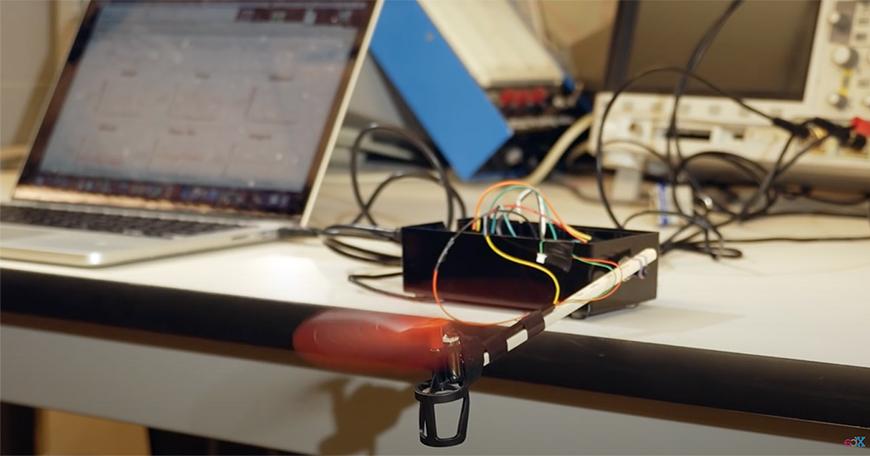6.302 Teaching Staff Provides Student-Centered Experience

In response to the COVID-19 pandemic, Computer Science Professor Jacob White and his teaching staff taught the second half of 6.302 (Feedback System Design) entirely remotely. 6.302 is a learn-by-design course that focuses on continuous and discrete-time system modeling and feedback control. Students design and build controllers that can suspend a magnet in mid-air and direct a propeller-levitated arm.
In normal on-campus circumstances, students in 6.302 completed five online pre-labs, worked in pairs during a 3-hour lab section to fulfill their design labs requirements, and then completed five online post-labs. To enable students to work remotely, asynchronously, and individually across a range of skillsets, instructors needed to significantly restructure the entire educational experience. A modified version of the original synchronous, pair-oriented, on-campus class would not work. Major revisions were necessary. Students needed more scaffolding, more support, and a wide range of channels through which to connect with the class, the staff, and the material.
The following interventions were implemented:
Remote labs
White’s teaching staff of graduate students — Kavya Ravichandran, Aaron Wubshet, Lokhin Cheng, Roderick S Bayliss, Irene A Kuang, and Anthony Pennes — assembled and distributed complete hardware kits for each student to take home with them. The hardware kits included equipment for two design labs (magnetic levitation and propeller-arm positioning), as well as software to enable students to screen share their measured data in real time. When students needed replacement parts, the team shipped the parts to their homes.
Student collaboration balanced with individual accountability
Rather than complete individual labs as they would on campus, students were encouraged to collaborate remotely with their peers. Although students could work together, each was still required to participate in a series of one-on-one checkoff interviews with teaching staff. Through this process, students demonstrated their working controller and a comprehensive understanding of the design issues involved.
Multi-channel support: preparation, help, peer-instruction
In the post-campus environment, it became clear that students working and learning remotely would need additional support and preparation. To replace the original 6.302 prelab problems, White and his team created a set of five online prelab problem sets that better prepared students for their labs: each design lab included videos of working setups to set student expectations, as well as guidelines for what was required to pass each of the three extensive one-on-one checkoff interviews successfully.
Prof White and his teaching colleagues were committed to building community and student engagement in the remote environment. They addressed the challenge of keeping 135 students engaged, given diverse technical backgrounds and varying levels of seniority, by implementing the following strategies:
- For students wanting a synchronous experience, Prof White continued to deliver lectures during regular class times, which 1/3 of the class opted to attend.
- To encourage peer-to-peer instruction, graduate students received additional credit for volunteering to support their peers. Piazza was used to connect graduate student mentors to mentees. Over 1/3 of the class took advantage of this offer.
- For hands-on work, multiroom three-hour lab Zoom sessions were scheduled, allowing for 3-4 students per room.
Although White and his teaching staff held open office hours using a Zoom “common room,” few students took advantage of it. However, there remained a distinct need for support resources. The one-on-one checkoff interviews gave a clear picture of the dramatic differences in student situations and rates of progress. In response, the teaching staff dramatically increased office hours to nearly four hours a day. The schedules spanned from early morning to late evening to accommodate students throughout globally dispersed time zones. CAT-SOOP, a platform designed by Adam Hartz, was used to organize and monitor the help queue. Students could sign up to either get help or request checkoff interviews by adding themselves to the queue. When they reached their turn, students were automatically assigned a zoom link where they would meet staff and begin the interview or help session. In addition to the help queue, CAT-SOOP was used for distributing course materials and assignments as well as for automatic assessment of the labs and homeworks.
White and his staff also allowed students to continue working beyond the last class and even beyond final exams. Incompletes were granted on request and the teaching team continued to hold daily office hours until May 31, making it feasible for a significant number of students to complete the class and finish their projects.
Dedication of 6.302 teaching team
Reflecting on the semester and challenges that his team overcame, Prof White praised the hard work, agility, and commitment of his teaching staff, Kavya Ravichandran, Aaron Wubshet, Lokhin Cheng, Roderick S. Bayliss, Irene A. Kuang, and Anthony Pennes. The time and energy required to connect with and follow a class of 135 students was staggering. Each of the two design labs required three 30-minute checkoff interviews. The result was more than 400 hours of interviews total, in addition to extensive office hours, Piazza post answering, and more.
The success of 6.302 serves as a testament to what a small, dedicated group of teaching staff can accomplish.

